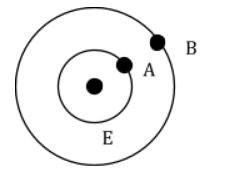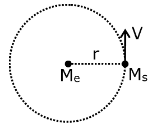
Two satellites A and B of masses 200 kg and 400 kg are revolving round the earth at height of 600 km and 1600 km respectively.
If $T_A$ and $T_B$ are the time periods of A and B respectively then the value of ${T_B} – {T_A}$:

[Given: Radius of earth = 6400 km, mass of earth = $6\times {10^24} kg$]
(A) $4.24 \times {10^2} s$
(B) $3.33\times {10^2} s$
(C) $1.33 \times {10^3} s$
(D) $4.24 \times {10^3} s$
Answer
221.7k+ views
Hint: Since no specific details of the trajectory is given, we will take the circular orbit as the path of the satellite. Now we can find the velocity of the satellite by equating the gravitational force equal to the centripetal force. From this we can calculate the time period of revolution as the speed and the distance covered in one revolution is given to us.
Formula used:
${F_G} = \dfrac{{GMm}}{{{r^2}}}$
${F_C} = \dfrac{{m{v^2}}}{r}$
Complete answer:
From the diagram given below we can find the velocity of the object 'S' by using the above given formula.

${F_G} = \dfrac{{G{M_e}{M_S}}}{{{r^2}}}$is the force of gravitation.
${F_C} = \dfrac{{{M_S}{v^2}}}{r}$ is the centripetal force.
Since both of them are equal we can equate them to find the value of velocity.
$\dfrac{{{M_S}{v^2}}}{r} = \dfrac{{G{M_e}{M_S}}}{{{r^2}}}$
$ \Rightarrow v = \sqrt {\dfrac{{G{M_e}}}{r}} $
This shows that velocity does not depend on the mass of the object.
We have the velocity of the object, we can find the velocity of the masses by replacing each of the variables with the respective values for the masses A and B.
Since it is a circular orbit the total distance is $2\pi r$ where r is the distance from the centre of the earth to the masses. The time period of revolution is:
$T = \dfrac{{2\pi r}}{v} = \dfrac{{2\pi r}}{{\sqrt {\dfrac{{G{M_e}}}{r}} }}$ where $v = \sqrt {\dfrac{{G{M_e}}}{r}} $
$ \Rightarrow T = \sqrt {\dfrac{{4{\pi ^2}{r^3}}}{{G{M_e}}}} $
The time period is proportional with the distance from the centre, we only need to worry about the distance only. Thus, the difference of their time period will be
\[{T_B} - {T_A} = \sqrt {\dfrac{{4{\pi ^2}{r_B}^3}}{{G{M_e}}}} - \sqrt {\dfrac{{4{\pi ^2}{r_A}^3}}{{G{M_e}}}} \]
\[{T_B} - {T_A} = \dfrac{{2\pi }}{{\sqrt {G{M_e}} }}\left( {{r_B}^{\dfrac{3}{2}} - {r_A}^{\dfrac{3}{2}}} \right)\]
\[{T_B} - {T_A} = \dfrac{{2\pi }}{{\sqrt {G{M_e}} }}\left( {{{\left( {1600} \right)}^{\dfrac{3}{2}}} - {{\left( {600} \right)}^{\dfrac{3}{2}}}} \right)\]
\[{T_B} - {T_A} = 1.33 \times {10^3}s\]
Thus, the difference in their time period will be $1.33 \times {10^3} s$. The correct option is (C).
Note: Rather than deriving the formula of the velocity it is quite useful to note that the formula for a masses revolving around earth is equal to where M is the mass of the earth G is the gravitational constant and r is the distance from the centre of the earth is $v = \sqrt {\dfrac{{G{M_e}}}{r}} $
We can also use the Kepler's law to find the proportional factor of time period as we know that$\left( {{T^2} \propto {R^3}} \right)$ where T is the time period and R is the distance from the centre of the earth or a mass object.
Formula used:
${F_G} = \dfrac{{GMm}}{{{r^2}}}$
${F_C} = \dfrac{{m{v^2}}}{r}$
Complete answer:
From the diagram given below we can find the velocity of the object 'S' by using the above given formula.

${F_G} = \dfrac{{G{M_e}{M_S}}}{{{r^2}}}$is the force of gravitation.
${F_C} = \dfrac{{{M_S}{v^2}}}{r}$ is the centripetal force.
Since both of them are equal we can equate them to find the value of velocity.
$\dfrac{{{M_S}{v^2}}}{r} = \dfrac{{G{M_e}{M_S}}}{{{r^2}}}$
$ \Rightarrow v = \sqrt {\dfrac{{G{M_e}}}{r}} $
This shows that velocity does not depend on the mass of the object.
We have the velocity of the object, we can find the velocity of the masses by replacing each of the variables with the respective values for the masses A and B.
Since it is a circular orbit the total distance is $2\pi r$ where r is the distance from the centre of the earth to the masses. The time period of revolution is:
$T = \dfrac{{2\pi r}}{v} = \dfrac{{2\pi r}}{{\sqrt {\dfrac{{G{M_e}}}{r}} }}$ where $v = \sqrt {\dfrac{{G{M_e}}}{r}} $
$ \Rightarrow T = \sqrt {\dfrac{{4{\pi ^2}{r^3}}}{{G{M_e}}}} $
The time period is proportional with the distance from the centre, we only need to worry about the distance only. Thus, the difference of their time period will be
\[{T_B} - {T_A} = \sqrt {\dfrac{{4{\pi ^2}{r_B}^3}}{{G{M_e}}}} - \sqrt {\dfrac{{4{\pi ^2}{r_A}^3}}{{G{M_e}}}} \]
\[{T_B} - {T_A} = \dfrac{{2\pi }}{{\sqrt {G{M_e}} }}\left( {{r_B}^{\dfrac{3}{2}} - {r_A}^{\dfrac{3}{2}}} \right)\]
\[{T_B} - {T_A} = \dfrac{{2\pi }}{{\sqrt {G{M_e}} }}\left( {{{\left( {1600} \right)}^{\dfrac{3}{2}}} - {{\left( {600} \right)}^{\dfrac{3}{2}}}} \right)\]
\[{T_B} - {T_A} = 1.33 \times {10^3}s\]
Thus, the difference in their time period will be $1.33 \times {10^3} s$. The correct option is (C).
Note: Rather than deriving the formula of the velocity it is quite useful to note that the formula for a masses revolving around earth is equal to where M is the mass of the earth G is the gravitational constant and r is the distance from the centre of the earth is $v = \sqrt {\dfrac{{G{M_e}}}{r}} $
We can also use the Kepler's law to find the proportional factor of time period as we know that$\left( {{T^2} \propto {R^3}} \right)$ where T is the time period and R is the distance from the centre of the earth or a mass object.
Recently Updated Pages
Uniform Acceleration Explained: Formula, Examples & Graphs

JEE Main 2022 (July 26th Shift 1) Physics Question Paper with Answer Key

JEE Main 2022 (June 26th Shift 2) Chemistry Question Paper with Answer Key

Apparent Frequency Explained: Formula, Uses & Examples

JEE Main 2023 (January 30th Shift 2) Chemistry Question Paper with Answer Key

JEE Main 2023 (April 15th Shift 1) Physics Question Paper with Answer Key

Trending doubts
JEE Main 2026: Application Form Open, Exam Dates, Syllabus, Eligibility & Question Papers

Derivation of Equation of Trajectory Explained for Students

Hybridisation in Chemistry – Concept, Types & Applications

Understanding the Angle of Deviation in a Prism

How to Convert a Galvanometer into an Ammeter or Voltmeter

Degree of Dissociation: Meaning, Formula, Calculation & Uses

Other Pages
JEE Advanced Marks vs Ranks 2025: Understanding Category-wise Qualifying Marks and Previous Year Cut-offs

Thermodynamics Class 11 Physics Chapter 11 CBSE Notes - 2025-26

Units And Measurements Class 11 Physics Chapter 1 CBSE Notes - 2025-26

NCERT Solutions For Class 11 Physics Chapter 8 Mechanical Properties Of Solids

Motion in a Straight Line Class 11 Physics Chapter 2 CBSE Notes - 2025-26

Laws of Motion Class 11 Physics Chapter 4 CBSE Notes - 2025-26




